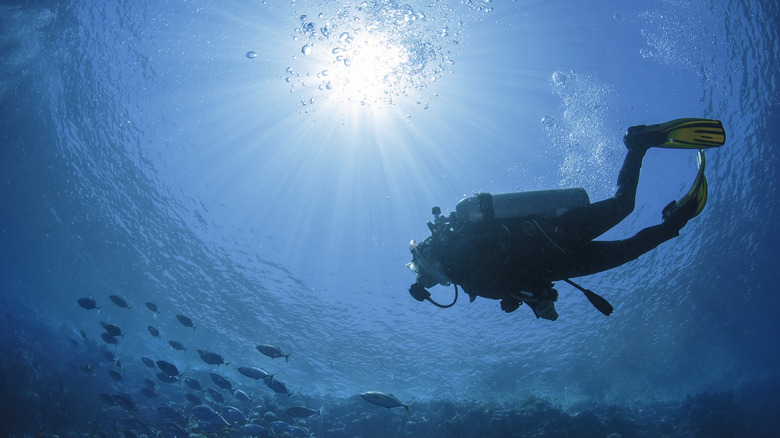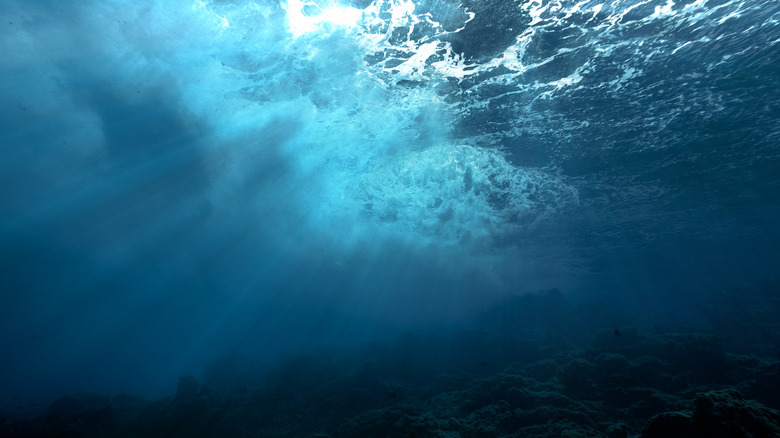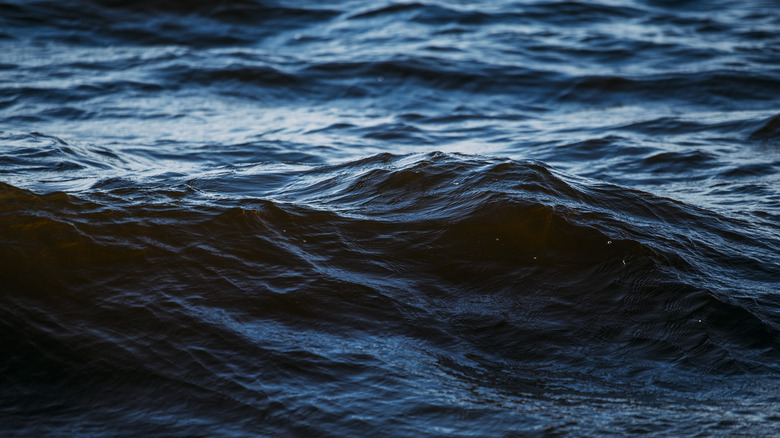The Deepest Fish Ever Caught On Camera Was Found Over 5 Miles Under The Sea
While many look to space for exploratory inspiration, others look down toward the deepest, bluest depths of Earth's oceans. After all, more than 80% of our own planet's waters remain unmapped. Satellites can zoom in on the tiniest, most minute detail of Earth's surface — down to centimeters of width — but the darkest places beneath the waves remain unseen. This gives the imagination a chance to run wild: legends of ship-crippling sea monsters and sirens luring sailors to their deaths, tales of ancient civilizations like Atlantis sinking beneath the surface, H.P. Lovecraft's Cthulhu mythos centering on realms of underwater madness, stories like Jules Verne's 1870 "Twenty Thousand Leagues Under the Sea," and much more.
But when it comes to the truth of the world beneath the ocean's surface, reality can be a bit underwhelming. Yes, we've got giant vents steaming volcanic plumes, tectonic ridges that slip and slide and cause earthquakes aboveground, marine megafauna like giant squids, creepy and bizarro fish like the angler fish with its disturbing maw of thin, craggy teeth, some wreckages of ancient and modern ships, etc. But beyond that there's just a whole lot of sand. And saltwater, of course. Definitely no singing crabs and red-headed mermaids gazing up and crooning to be "part of that world."
And yet, lots of deep-sea life remains to be found. Take a recent find off the coast of Japan at a depth of 5 miles: the somewhat cute, benign-looking deep snailfish with a vacant gaze and hearty appetite.
Creature of the deep
It's the depth (literally) of the current discovery that will make it impressive to most readers. Actual researchers, though, as NPR quotes, are more than a bit excited about the fish — an unknown member of the Pseudoliparis genus — they discovered, saying, "We have spent over 15 years researching these deep snailfish; there is so much more to them than simply the depth, but the maximum depth they can survive is truly astonishing."
As the University of Western Australia says, the current find is the deepest a fish has ever been found: 8,336 meters (about 5 miles). That's about as deep as Mt. Everest is tall. Compare that to 213.9 meters, the deepest a human has ever free dove, a record set in 2007. Depths below about 60 meters can cause oxygen toxicity in humans, resulting in convulsions and widespread organ damage. To put things in further perspective, the deep snailfish lives at a depth of only 2 miles higher than the deepest part of the entire ocean: the 7-mile-deep Challenger Deep at the southern tip of the Mariana Trench. While it's possible that fish — not sea cucumbers, shrimp, amoebas, etc. — might live even deeper, right now this is the deepest we've found them.
The University of Western Australia says that the previous deepest depth we've found any fish was 7,703 meters in 2008. A couple of days before making their deepest find, the team also found some deep snailfish at 8,022 meters.
The deep-water trenches of Japan
Per the University of Western Australia (UWA), the team responsible for the deep snailfish find embarked on a 10-year journey into three different deep-water trenches near Japan: the Ryukyu trench (7,300 meters), the Japan Trench (8,000 meters), and the Izu-Ogasawara Trench (9,300 meters). They found the deepest deep snailfish last August 2022 in the Izu-Ogasawara Trench, which extends south from Tokyo in a near-straight line.
Founder of UWA's Minderoo-UWA Deep Sea Research Centre and team lead Professor Alan Jamieson said, "The Japanese trenches were incredible places to explore; they are so rich in life, even all the way at the bottom." He also said that there's an unusually high number of deep snailfish in the trenches near Japan: "In other trenches such as the Mariana Trench, we were finding them at increasingly deeper depths ... in fewer and fewer numbers, but around Japan they are really quite abundant."
As the University of Western Australia explains, the team attracted the attention of the fish through the most common-sense means possible: food. Pictures show a smorgasbord of seafood tied to the end of a metal pole sticking out into the water and loads of deep snailfish mobbing it for a bite. Deep snailfish generally live in active, social communities, with younger fish heading to deeper depths than older fish. And indeed, the deepest, record-breaking fish was extremely young. This expedition was also the first time a team had seen any fish in the Izu-Ogasawara Trench whatsoever.


